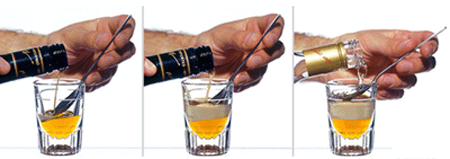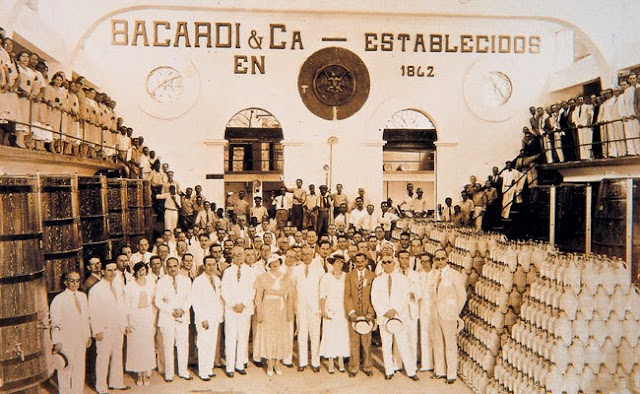Layered Drinks
Beautifully Delicious!
Everybody’s seen one – a multi-colored layered drink that just looks more fun than a stodgy old rum and coke. These gorgeous, exotic-looking thirst quenchers are proof that you eat with your eyes first, but what exactly goes into making a layered cocktail? How in the name of all that’s delicious do they get those liquids to stay put?
Great question! Making beautiful layered drinks requires a combination of science, technical skill and a working knowledge of flavour profiles. It works so well that top chefs such as Ferran Adria use them to ensure that their layered cocktails and soups turn out perfectly.
Whether you’re an experienced mixologist looking to pick up a few new tips or just somebody who wants to learn how it’s done, stick around! By the end of this page, you’re going to learn the molecular magic behind layered drinks, what methods work best to make successful layered drinks!
What is a Layered Drink?
 |
| Liberation by Elvio |
Layered cocktails began in Europe around the turn of the 20th century as a way to add aesthetic appeal and varied flavour profiles to alcoholic beverages. Also known as pousse-café, layered drinks have become extremely popular around the globe and are typically created using three to seven different liquids that vary in density and viscosity. Different temperatures may also be used to further enhance the experience and some true cocktail masters even experiment with different textures.
How Do You Make a Layered Cocktail?
Layering drinks isn’t just an art form; it’s a science. In order to effectively create a layered cocktail, you’re going to need to know a bit about the weight and density of each component. The liquids are layered with the heaviest or densest ingredient on the bottom and the lightest or least dense one on the top. A good rule of thumb is that the sweeter a liquid is, the denser it’s going to be.
Though layered cocktails are an impressive way to show off mixology skills, layering drinks can be extremely time-consuming, especially if multiple layers and/or multiple temperatures are involved. There are two manual ways to execute a layered drink recipe.
Regardless of which method you use, you’ll need to figure out the order of layering first, then determine how much of each ingredient you’ll need. Most mixologists use the eyeball method here – just visually divide the glass into however many sections you’ll need. In other words, if your layered drink has 3 components, imagine the glass divided into three sections, leaving room at the top to avoid spillage.
Though layered cocktails are an impressive way to show off mixology skills, layering drinks can be extremely time-consuming, especially if multiple layers and/or multiple temperatures are involved. There are two manual ways to execute a layered drink recipe.
Regardless of which method you use, you’ll need to figure out the order of layering first, then determine how much of each ingredient you’ll need. Most mixologists use the eyeball method here – just visually divide the glass into however many sections you’ll need. In other words, if your layered drink has 3 components, imagine the glass divided into three sections, leaving room at the top to avoid spillage.
The Spoon Method
 |
Spoon Method
|
The traditional way to make a layered cocktail is to use a spoon to carefully pour one layer on top of another, following the weight and volume rule. If you’re using a layered drink recipe, this part will be easy: just follow the directions. If you’re creating your own layered cocktail, make sure that you have the order right according to weight/density or else you’ll end up with a sludgy mess.
1 – Place the heaviest component in the bottom of the glass.
2 –Turn your soup spoon or bar spoon upside down and place the tip of the spoon at the top edge of the bottom layer without actually touching the liquid.
3 – Carefully and slowly pour the next ingredient onto the back of the spoon, letting it run gently onto the top of the bottom layer so that it floats on top.
4 – Rinse and dry your spoon and repeat with the next component until your layered cocktail is complete.
As you can imagine, this method of layering drinks is extremely time-consuming for even the most experienced mixologist. That’s why most high-volume restaurants and lounges don’t offer many layered cocktails; making them can quickly throw a busy bartender into the weeds.
The Syringe Method
 |
| layering cocktails with Syringe |
This method of layering drinks is a little bit faster than the spoon method but is still extremely inefficient if the mixologist is busy. The process is basically the same but instead of pouring your ingredients over a spoon, you’re going to use a syringe meant for dispensing liquid medications.
1 – Add your heaviest/densest ingredient to the bottom of the glass.
2 – Fill your syringe with the correct amount of the next ingredient.
3 – Place the tip of the syringe against the inside of the glass at the top of the bottom layer.
4 – Gently push the plunger so that the contents float on top of the bottom layer.
5 – Repeat until your layered cocktail is complete.
Make sure that you rinse your syringe in between layers to avoid mixing flavours and colours or changing the density of the ingredient. There are two advantages to this method:
1 – It’s easier to use the correct amount of each ingredient since it’s pre-measured.
2 – It’s less awkward than trying to hold the spoon and pour from the bottle.




Comments
Post a Comment